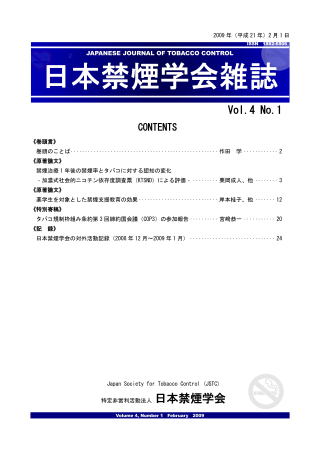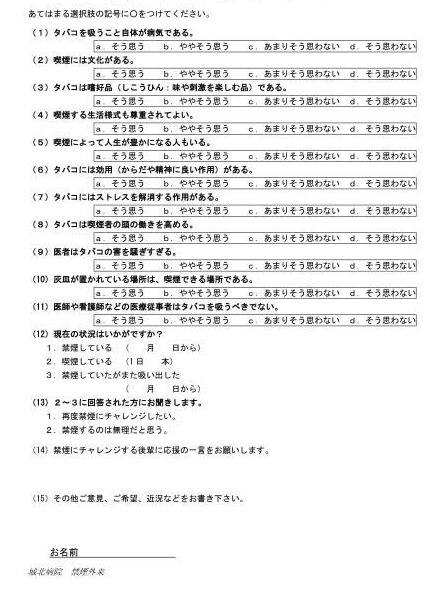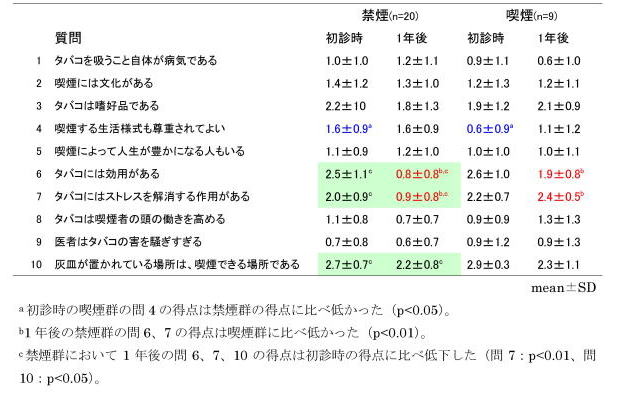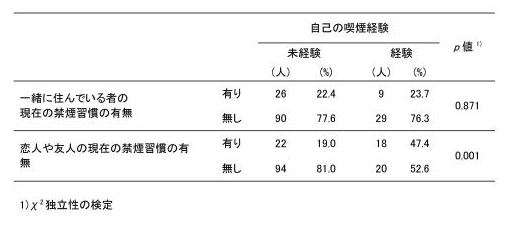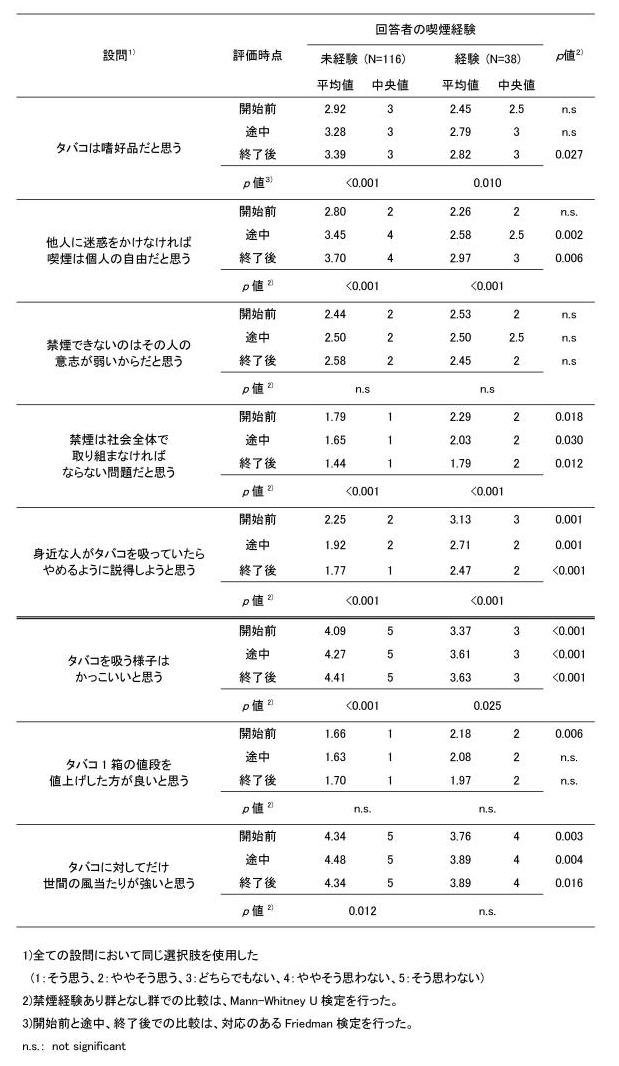参考文献
| 1) |
日本循環器学会等合同研究班:禁煙ガイドライン. Circulation Journal 2005;69. Supple. :1006-1103. |
| 2) |
栗岡成人,師岡康子,吉井千春,ほか:禁煙保険治療3か月後の治療効果と今後の課題.禁煙会誌 2008;3:4-6. |
| 3) |
日本循環器学会・日本肺癌学会・日本癌学会編:禁煙治療のための標準手順書第2版. 2007年
http://www.j-circ.or.jp/kinen/anti_smoke_std/anti_smoke_std_rev2.pdf Accessed for Dec 27, 2007. |
| 4) |
川井治之:ニコチネルTTSを用いた禁煙プログラムによる1年(長期)禁煙率と安全性の検討.医薬ジャーナル 2008;44:149-153. |
| 5) |
厚生労働省中央社会保険医療協議会総会 診療報酬改定結果検証に係る特別調査(平成19 年度調査)ニコチン依存症管理料算定保険医療機関における禁煙成功率の実態調査報告書(中医協20.7.9).
http://www.mhlw.go.jp/shingi/2008/07/dl/s0709-8k.pdf Accessed for July 9, 2008. |
| 6) |
川井治之、柴山卓夫、多田敦彦、河原伸、宗田良、高橋清:ニコチンパッチを使用した禁煙外来患者における禁煙達成に影響する因子の検討.日呼吸会誌 2005;43:144-149. |
| 7) |
高橋浩、加藤博也、藤本佳史:当院におけるニコチンパッチによるニコチン代替療法の2年間の成績. 広島医学 2001;54:666-668. |
| 8) |
高木啓吾、加藤信秀、笹本修一、泰美暢:禁煙外来の実際 日気食会報 2005;56:424-430. |
| 9) |
Yoshii C, Kano M, Isomura T, et al: An Innovative Questionnaire Examining Psychological Nicotine Dependence, “The Kano Test for Social Nicotine Dependence (KTSND) ”. J UOEH 2006; 28 : 45-55. |
| 10) |
吉井千春, 加濃正人, 稲垣幸司, ほか: 加濃式社会的ニコチン依存度調査票を用いた病院職員(福岡県内3病院)における社会的ニコチン依存の評価.
禁煙会誌 2007;2:6-9. |
| 11) |
吉井千春,栗岡成人,加濃正人,ほか:加濃式社会的ニコチン依存度調査票(KTSND)を用いた「みやこ禁煙学会」参加者の喫煙に関する意識調査.禁煙会誌 2008;3:26-30. |
| 12) |
栗岡成人,稲垣幸司,吉井千春,ほか:加濃式社会的ニコチン依存度調査票による女子学生のタバコに対する意識調査(2006年度).禁煙会誌 2007;2:3-5. |
| 13) |
栗岡成人,吉井千春,加濃正人:女子学生のタバコに対する意識 加濃式社会的ニコチン依存度調査票Version 2による解析.京都医会誌 2007;54:181-185. |
| 14) |
遠藤 明,加濃正人,吉井千春,ほか:小学校高学年生の喫煙に対する認識と禁煙教育の効果.禁煙会誌 2007;2:10-12. |
| 15) |
遠藤 明, 加濃正人, 吉井千春, ほか:中学生の喫煙に対する認識と禁煙教育の効果.禁煙会誌 2008;3:48-52. |
| 16) |
遠藤 明,加濃正人,吉井千春,ほか:高校生の喫煙に対する認識と禁煙教育の効果.禁煙会誌 2008;3:7-10. |
| 17) |
星野啓一、谷口千枝、稲垣幸司ら:加濃式社会的ニコチン依存度質問表(KTSND)は半年後の禁煙成功者を予測しえるか?(初回面接時のKTSND差分の有用性について)(会).第2回日本禁煙学会学術総会プログラム・抄録集 2007 p48.
http://www.nosmoke55.jp/gakkai/200708/0708jstc_council.pdf Accessed for Oct 26, 2008. |
|
|
Smoking cessation rate one-year after smoking cessation program and evaluation of smoker’s perception of smoking using the KTSND (The Kano Test for Social Nicotine Dependence) questionnaire.
Narito Kurioka1,6, Ikumi Hirota1, Chiharu Yoshii2,6, Koji Inagaki3,6, Izumi Sezai4,6, Masato Kano5,6
We evaluated sixty-one outpatients who visited the smoking cessation clinic
at Johoku Hospital from April 1st 2006 to March 31st 2007. A 61 patients
were composed of:is as follows: 35 male and 26 female patients, mean age
51.7 ± 13.2 (mean ± SD) ranging in age from 28 to 74 years old, Age of
starting smoking 22.9 ± 8.2 ranged from 13 to 58 years old, number of cigarettes
per day 27.6 ± 13.8 from 8 to 90, , smoking index(number of cigarettes
per day×years of smoking) 767.2 ± 469.0 from 200 to 2520, TDS(Tobacco Dependence
Screener) 7.8 ± 1.5 from 5 to 10, FTQ (Fagerström Tolerance Questionnaire)
6.1 ± 1.9 from 3 to 10, KTSND (The Kano Test for Social Nicotine Dependence
) 15.1 ± 4.9 from 3 to 28, CO concentration 25.5 ± 14.5 ppm from 4 to 78
ppm, The starting age of smoking was significantly higher in females and
the smoking index and the scores on the KTSND were significantly lower
in females. We regarded patients who reported they had quit smoking as
successful and patients who reported they have continued or returned smoking
or did not answer as unsuccessful. One-year after treatment the number
of the patients who succeeded in quitting was 22, that is, the success
rate one-year after treatment was 36.1%. Comparing the successful group
to the unsuccessful group, the rate of family members who smoke was significantly
higher in the unsuccessful group. The KTSND was used to evaluate the changes
in the patient’s perception of smoking. The KTSND has 10 questions, which
contain questions group on justifying the usefulness of smoking, neglecting
the harm of smoking, regarding smoking as a cultural or personal preference.
In the successful group, the KTSND score on positive perception of smoking
was significantly lower after one year, especially on the group of questions
on justifying the usefulness of smoking.
Key words: smoking cessation program, smoking cessation rate, psychological
nicotine dependence, The Kano Test for Social Nicotine Dependence (KTSND)
1.Johoku Hospital, Kyoto, Japan
2.Division of Respiratory Disease, University of Occupational and Environmental Health Japan, Kitakyushu, Japan
3.Department of Dental Hygiene, Aichi-Gakuin University Junior College, Nagoya, Japan
4.Graduate School of Comprehensive Human Sciences University of Tsukuba,Tsukuba, Japan
5.Shinnakagawa Hospital, Yokohama, Japan
6.KTSND working group in Research Group on Smoke-Free Psychology, Japan
|
